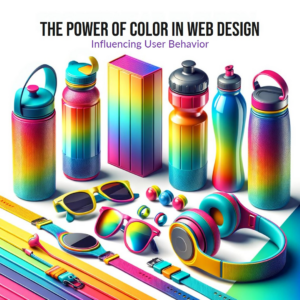Introduction:
Color is a powerful tool in web design, capable of evoking emotions, shaping perceptions, and influencing user behavior. By understanding the psychology of color and its impact on human cognition and perception, web designers can create visually compelling and effective websites that resonate with users on a subconscious level. In this guide, we explore the psychology of color in web design, uncovering the meanings, associations, and effects of different colors and providing actionable insights for leveraging color to enhance user experience and engagement.

1. Understanding Color Psychology:
Color psychology is the study of how colors affect human emotions, moods, and behaviors. Different colors evoke different emotional responses and associations, tapping into deep-seated cultural, biological, and psychological factors. For example:
– Red: Associated with passion, excitement, and urgency, red can stimulate appetite and create a sense of urgency or excitement.
– Blue: Symbolizing trust, calmness, and professionalism, blue is often used by brands to convey reliability and competence.
– Yellow: Eliciting feelings of warmth, positivity, and optimism, yellow can grab attention and convey a sense of happiness or energy.
– Green: Evoking associations with nature, growth, and health, green is often used to convey freshness, sustainability, and tranquility.
– Purple: Symbolizing luxury, creativity, and spirituality, purple can create a sense of elegance and sophistication.
2. Applying Color in Web Design:
In web design, color plays a critical role in shaping user perceptions, guiding navigation, and eliciting desired responses. Here are some key considerations for applying color in web design:
– Brand Identity: Use colors that align with your brand’s identity, values, and personality to create a cohesive and memorable brand experience.
– Visual Hierarchy: Use color to create visual hierarchy and guide users’ attention to important elements such as headlines, calls-to-action, and navigation menus.
– Emotional Impact: Consider the emotional impact of colors on your target audience and use them strategically to evoke desired emotions and associations.
– Readability and Accessibility: Ensure sufficient contrast between text and background colors to enhance readability, and consider color blindness and accessibility guidelines when selecting colors.
– Cultural Sensitivity: Be mindful of cultural differences and associations with colors, as meanings and interpretations may vary across different cultures and regions.
3. Color Combinations and Contrast:
In addition to individual colors, the combination of colors and their contrast play a crucial role in web design. Here are some tips for creating harmonious color palettes and effective contrast:
– Complementary Colors: Pair complementary colors (colors opposite each other on the color wheel) to create vibrant and visually appealing combinations.
– Analogous Colors: Use analogous colors (colors adjacent to each other on the color wheel) to create harmonious and cohesive color schemes.
– Contrast: Ensure sufficient contrast between text and background colors to enhance readability, and use contrast strategically to draw attention to important elements and create visual interest.
4. Testing and Iteration:
As with all aspects of web design, it’s essential to test and iterate on your color choices to ensure they resonate with your target audience and achieve your desired outcomes. Conduct A/B tests to compare different color schemes and variations, and analyze user feedback and behavior to inform your design decisions.
By staying agile, experimenting with different color combinations, and listening to user feedback, you can create web designs that effectively leverage the psychology of color to engage users, enhance usability, and achieve your business objectives.
Conclusion:
The psychology of color is a powerful tool in web design, offering designers the ability to evoke emotions, shape perceptions, and influence user behavior. By understanding the meanings, associations, and effects of different colors, and applying them strategically in web design, designers can create visually compelling and effective websites that resonate with users on a subconscious level.
As you incorporate color into your web design projects, remember to consider factors such as brand identity, emotional impact, readability, and cultural sensitivity. By leveraging color strategically and iteratively testing and refining your designs, you can create web experiences that engage users, enhance usability, and achieve your desired outcomes.



